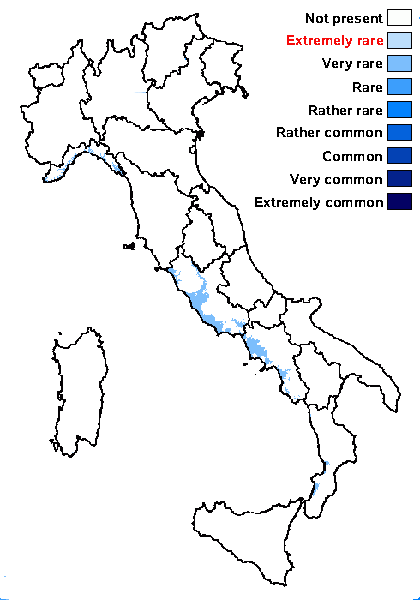Coenogonium tavaresianum (Vězda) Lücking, Aptroot & Sipman
in Rivas Plata & al., Fungal Divers., 23: 298, 2006. Basionym: Dimerella tavaresiana Vezda - Folia Geobot. Phytotaxon., 4: 446, 1969.
Synonyms:
Distribution: N - Lig. C - Tosc (Fačkovcová & al. 2024), Laz (Ravera & al. 1999, 2000, Munzi & al. 2004, 2007). S - Camp (CLU 17151), Bas (Bartoli & Puntillo 1996, 1998), Cal (Sérusiaux 1998).
Description: Thallus crustose, endosubstratic or thinly episubstratic, continuous, minutely granulose to verrucose, olive-green to glaucous green. Apothecia biatorine, adnate, clearly constricted at base, round, (0.1-)0.2-0.3(-0.5) mm across, pale to medium orange-brown, with a concave to flat disc, and a usually somewhat darker, persistent, smooth proper margin. Proper exciple paraplectenchymatous, orange-brown in outer part, colourless within, composed of globose to angular cells with an outer layer of weakly vertically oriented hyphae; hymenium colourless, (90-)100-120 µm high, I+ blue, then rapidly dirty green and finally red-brown; paraphyses simple or sparingly branched in upper part, 1-2 µm thick at mid-level, the apical cells swollen, to 3.5 µm wide; hypothecium colourless, poorly developed. Asci 8-spored, unitunicate, thin-walled, narrowly cylindrical, without an amyloid ring around the apical pore, Catillaria-type, with uniseriate spores. Ascospores 1-septate, hyaline, narrowly ellipsoid, (10-)12-16 x 2.5-4 µm. Pycnidia not known. Photobiont trentepohlioid. Spot tests: K-, C-, KC-, P-, UV-. Chemistry: without lichen substances. Note: a mild-temperate lichen found on acid bark of conifers and broad-leaved trees in open, humid and warm Mediterranean woodlands; strictly Tyrrhenian in Italy. It is included in the Italian red list of epiphytic lichens as “Vulnerable” (Nascimbene & al. 2013c).
Growth form: Crustose
Substrata: bark
Photobiont: Trentepohlia
Reproductive strategy: mainly sexual
Most common in areas with a humid-warm climate (e.g. most of Tyrrenian Italy)
Commonnes-rarity: (info)
Alpine belt: absent
Subalpine belt: absent
Oromediterranean belt: absent
Montane belt: absent
Submediterranean belt: absent
Padanian area: absent
Humid submediterranean belt: absent
Humid mediterranean belt: very rare
Dry mediterranean belt: absent

Predictive model
Herbarium samples
Growth form: Crustose
Substrata: bark
Photobiont: Trentepohlia
Reproductive strategy: mainly sexual
Most common in areas with a humid-warm climate (e.g. most of Tyrrenian Italy)
Commonnes-rarity: (info)
Alpine belt: absent
Subalpine belt: absent
Oromediterranean belt: absent
Montane belt: absent
Submediterranean belt: absent
Padanian area: absent
Humid submediterranean belt: absent
Humid mediterranean belt: very rare
Dry mediterranean belt: absent

Predictive model
| Herbarium samples |
 Index Fungorum
Index Fungorum
 GBIF
GBIF




